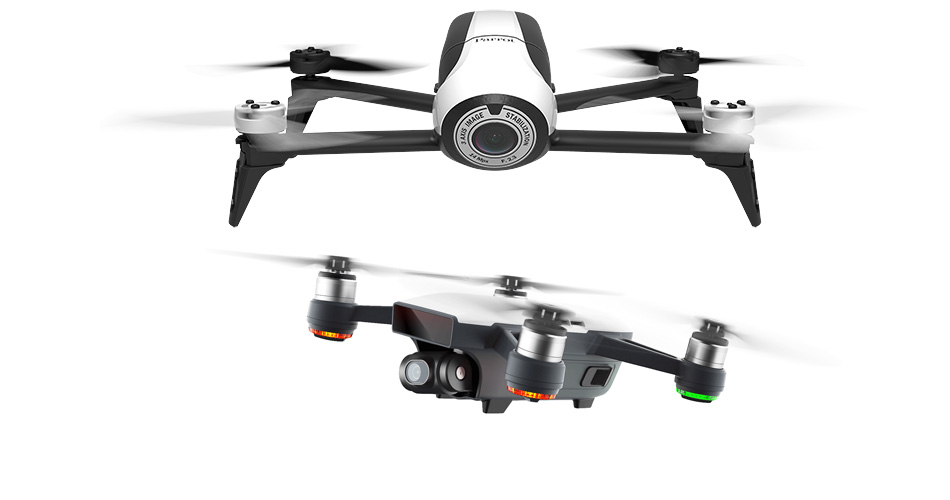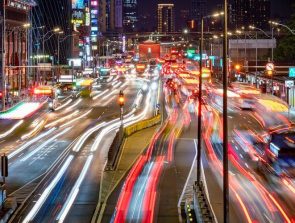Parrot Bebop 2 vs DJI Spark
The battle is on between two of the leading mini-drones on the market. Both are small, affordable, and offer an easy way to get flying. But which one is the best? Well, we have compared the crucial specs and functions to find out.
Price
Current Amazon prices are $550 for the Spark and $450 for the Bebop 2. These are for new models with controllers. Of course, it’s best to see for yourself as the prices always change. Also, you can avoid sales tax by buying from DJI.
+1 for the Bebop 2
Weight
Both drones are tiny and can almost fit in your pocket. This makes them highly portable no matter where you are going. The Spark weighs in at 300g while the Bebop 2 is 500g. Not a lot of difference, however, the Bebop 2’s additional weight helps it stand up to higher winds (more on this later).
Flight Time
The Spark can stay airborne for a maximum of 16 minutes, while the Bebop 2 can hit 25 minutes. This is a significant difference and a win for the Bebop 2. As both drones are similar in size and weight, the difference in flight time is, of course, due to the battery. The Spark has a 1480 mAh battery while the Bebop 2 has a 2700 mAh battery.
+1 for the Bebop 2
Max Speed
The Spark tops out at 31mph, with a maximum ascent and descent of 6.7mph. The Bebop 2 can hit 40mph with the same ascent and descent rates. Again not a massive difference but its always nice to know what’s under the hood.
+1 for the Bebop 2
Camera Capabilities
The Spark has a 12 Megapixel camera which can shoot 1080p video at up to 30fps. This isn’t exactly a powerful camera as far as drones go, however, it will still do the job. Now, the Bebop 2’s camera isn’t much of an improvement. It has 14 megapixels but the same 30fps at 1080p. Overall not a significant difference. Each camera will take decent photos and film in HD. However, professional and semi-professional filmmakers and photographers may want to look elsewhere.
+1 for the Bebop 2
Wind Resistance
Both drones are lightweight machines, but they can still be flown in windy conditions. The recommended maximum wind speeds for each drone are 22mph for the Spark and 24mph for the Bebop 2. Now, these are just recommended maximums. Many users have reported flying them in much stronger conditions. However, the battery will drain much faster, the camera will be less stable, and the risk of a crash is significantly increased.
+1 for the Bebop 2
Obstacle Avoidance
The Spark wins out here with its dedicated obstacle avoidance system. When turned on the system will detect any obstacles, such as building, branches, and fences, to automatically prevent the drone from crashing into them. Even if you were to fly directly at a tree, the drone would automatically stop before impact.
Unfortunately, the Bebop 2 misses out on this technology.
+2 for the Spark
Hovering
The Spark hovers in place better than the Bebop 2. Why? Because it has a vision positioning system that can effectively determine its location when low to the ground. This gives a much higher accuracy than using GPS/GLONASS.
+1 for the Spark
Controller Design
The Spark can be flown controller-less, just by using hand gestures or the DJI APP. However, we don’t recommend it. It is a novelty at first to wave your hands and have the drone take off and fly around but to utilize its full potential you need to purchase a controller. You can either buy one separately or get it included in a bundle deal. It doesn’t matter how you get it, just make sure you do.
Once you bring the controller into play the Spark’s operational range increase from 100m to 1.2miles. This is pretty important if you actually want to fly anywhere. You will also be getting two control sticks and a variety of dedicated and customisable buttons. Don’t forget about the sports mode button. This will allow the drone to hit its top speed of 31mph.
The Bebop 2 can also be flown without a controller, and once again we don’t recommend it. Users can control it entirely using the FreeFlight Pro App on a smartphone or tablet. However, the range and functions are severally limited. Just like the Spark, you need the controller to hit a max range of 1.2 miles.
Main Similarities
We would like to touch on some key functions that both drones have in common. Firstly, they both use GPS and GLONASS positioning. This helps them navigate effectively and gives them access to the maximum amount of available satellites.
Both drones have the “follow me” and “return home” functions. These can be operated through the DJI App and are pretty self-explanatory.
Each drone has a range of intelligent flight modes for taking photos and videos from a variety of angles. The Spark’s modes include:
- Dronie- The drone flies backward and forwards, while remaining locked on to a subject
- Circle- The drone flies in a circle (around a subject).
- Helix- The drone circles a subject but with the circle expanding in size over time.
The Bebop 2’s modes include:
- Tornado- Causes the drone to rise up in a spiral and then come down again, while locked onto a target.
- Parabola- Causes the drone to fly around the user in a semicircle.
- Boomerang- Causes the drone to fly away and then return, while locked onto a target.
The names may be different, but each drones’ modes function quite similar.
Overview
Let’s check out the total scores. And remember we have given the Spark two points for its obstacle avoidance capabilities because we reckon they extra important.
| Model | Features |
|---|---|
| Spark | 3 (Obstacle Avoidance (2 points), Hovering) |
| Bebop 2 | 5 (Flight Time, Max Speed, Camera, Wind Resistance, Price) |
While the Bebop 2 is the points winner, just remember it is only marginally ahead in most areas.
The table below makes things simple by comparing the main specifications and features.
| Feature | Spark | Bebop 2 |
|---|---|---|
| Weight | 300g | 500g |
| Flight Time | 16min | 25min |
| Max Speed | 31mph | 40mph |
| Camera | 12 Megapixels, 1080p at 30fps | 14 Megapixels, 1080p at 30fps |
| Wind Resistance | 22mph | 24mph |
| Obstacle Avoidance | Yes | No |
| Vision Positioning | Yes | No |
| Controller range | 1.2 miles | 1.2 miles |
| GPS/GLONASS | Yes | Yes |
| Estimated Price | $550 | $450 |
Which One Should You Get?
It’s a tough choice. Both mini-drones are very similar across a range of specifications. While the Bebop 2 has the overall top score, there is still not that much difference. They are both portable, have similar cameras, and have the same range. The Spark’s best feature its obstacle avoidance systems, while the Bebop 2 is the clear winner in flight time.
Now the Spark may be $100 more, but we think its obstacle avoidance system make up for this. This will reduce the chance of crashes and possibly save you money in the long run.
If you are new to flying then getting the Spark is probably the best idea because its obstacle avoidance can keep it safe from user error. Those who already have experience flying drones may want to get the Bebop 2 instead.
Before you go, we should mention that neither the Spark or Bebop 2 has a top of the range camera. If taking the best aerial photos and videos are your main reason for purchasing a drone then you may want to consider some of the other models on the market, such as the DJI Phantom 4 Pro or Inspire 2. If portability is your top concern, then the DJI Mavic Pro comes with a 4K camera with a foldable design.


